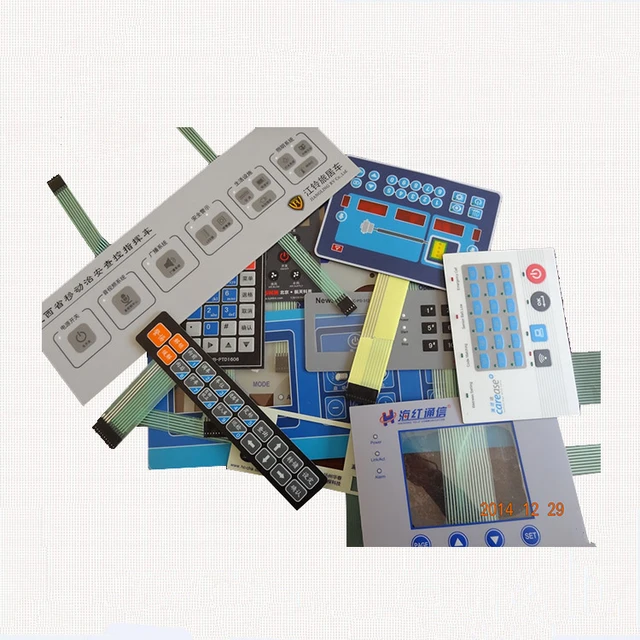Membrane Switch: Reliable, Cost-Effective, and User-Friendly Control Systems
Membrane Switch: Reliable, Cost-Effective, and User-Friendly Control Systems
Blog Article
Understanding Membrane Switches Over: The Key to Reputable and sturdy Controls

What Are Membrane Layer Buttons?
Membrane layer buttons are a sophisticated service in the world of interface modern technology, combining capability and layout perfectly. These gadgets act as a user interface in between users and electronic systems, incorporating numerous elements into a small format. Commonly created from adaptable, slim layers of products, membrane layer buttons are developed to reply to touch, allowing users to communicate with machinery and electronic tools effectively.
The primary components of a membrane layer button include a printed circuit layer, graphic overlay, and a spacer layer that prevents unintended activation. The graphic overlay can be tailored to mirror brand name identification or individual preferences, enhancing appearances while making certain use. Membrane layer buttons are typically utilized in various applications, consisting of medical devices, customer electronics, and industrial equipment, owing to their resilience and resistance to environmental variables such as moisture and dust.
Among the crucial advantages of membrane switches is their ability to withstand wear and tear, making them excellent for high-traffic settings. Furthermore, they are light-weight and need very little space, permitting for ingenious designs in item advancement. On the whole, membrane layer changes represent a reliable and useful selection for modern-day digital interfaces, weding innovation with user-centric layout principles.
Exactly How Membrane Changes Work
The operation of membrane switches over joints on a simple yet efficient device that equates user input into electronic signals. When a customer presses the button, the top layer deforms, enabling a conductive component in the circuit layer to make contact with a matching conductive pad on the bottom of the visuals overlay.
The design of membrane switches can vary, however they commonly incorporate domes or tactile elements to offer comments to the individual, boosting the general experience - membrane switch. The materials utilized in membrane layer buttons, such as polyester or polycarbonate, add to their durability and resistance to environmental elements, including wetness and dust. Moreover, the published circuits are normally enveloped, which protects them from wear and tear over time.
Benefits of Membrane Buttons

In addition, membrane layer buttons are recognized for their toughness. Created from robust products, they are immune to dirt, dampness, and physical wear, which considerably prolongs their life expectancy contrasted to typical mechanical buttons. This longevity makes them particularly appropriate for high-traffic environments and applications calling for longevity.
Another significant advantage is the simplicity of cleansing and upkeep. The smooth surface area of membrane layer changes lessens dust accumulation and is commonly resistant to spills, making them suitable for setups that need regular sanitization.
Furthermore, membrane buttons use a structured profile, resulting in a thinner design that can be incorporated right page into various devices without including bulk. This feature not just boosts the aesthetic allure yet additionally adds to a more ergonomic item design.
Applications of Membrane Layer Buttons
Functional and straightforward, membrane buttons discover applications across a wide variety of sectors, including clinical gadgets, consumer electronic devices, and commercial tools. In the clinical field, these buttons are important to devices such as analysis devices, patient surveillance systems, and infusion pumps, where integrity and simplicity of cleaning are essential. Their capacity to endure harsh atmospheres and maintain functionality makes them excellent for such applications.

In customer electronics, membrane layer buttons are used in items like microwaves, washing machines, and remotes - membrane switch. Their streamlined style enables instinctive user interfaces, improving the total user experience while supplying resilience and resistance to deterioration
Commercial tools also benefits from membrane layer buttons, specifically in control click panels for equipment visit our website and automation systems. These switches provide defense versus dirt and moisture, making sure constant efficiency in tough environments. Additionally, their adjustable attributes permit manufacturers to customize them to specific operational needs, improving effectiveness and performance.
Picking the Right Membrane Layer Switch Over
When picking a membrane layer button, it is vital to take into consideration different elements that influence performance and suitability for details applications. The key factors to consider consist of environmental conditions, responsive comments, longevity, and style specifications.
First, assess the operating environment; switches subjected to dampness, chemicals, or extreme temperatures need particular materials to ensure long life and capability. Next off, assess the demand for responsive comments. Depending on user interaction, some applications might take advantage of a responsive feedback to verify activation, while others may like a non-tactile layout for aesthetic factors.
Resilience is another important variable; membrane layer buttons ought to be made to endure frequent use, impacts, and abrasion. Guarantee the chosen button can withstand the expected lifecycle, especially in high-usage situations.

Final Thought
Finally, membrane switches serve as vital parts in the style of resilient and trustworthy control systems throughout various markets. Their portable style, combined with durable building and personalized features, boosts customer communication while guaranteeing durability sought after environments. The flexibility of membrane switches over permits customized options that fulfill certain operational requirements, reinforcing their value in modern-day technology. As industries proceed to advance, the importance of incorporating efficient membrane button options can not be overemphasized.
Membrane changes represent a critical aspect of modern user interface design, mixing capability with resilience in numerous applications.Membrane buttons are an innovative service in the world of customer interface modern technology, combining capability and layout perfectly. Typically constructed from flexible, slim layers of products, membrane switches are created to react to touch, enabling individuals to communicate with machinery and digital tools properly.
The design of membrane switches can vary, but they typically integrate domes or tactile components to offer feedback to the user, boosting the total experience.In conclusion, membrane layer switches over serve as necessary components in the design of reliable and sturdy control systems throughout various markets.
Report this page